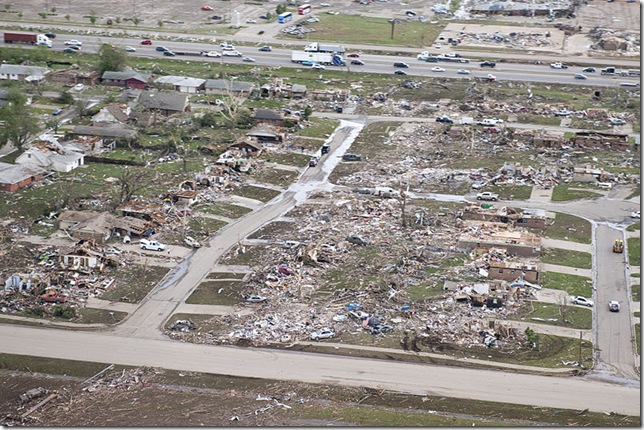By Myles Ludwig
Watching the Oklahoma tornado victims sifting through the debris of their lives night after night, newscast after newscast, is heartbreaking, of course. Each stick and splinter, each broken toy, each chair leg or slice of dining table, each refrigerator is a signifier of a piece of a once-treasured past now lost, a piece of heart torn away by the present.
But we have come to expect a certain kind of ritual now: the stunned misery and sadness followed by declarations of the inner strength of citizens from government officials, praise for their resiliency, exhortations to rebuild, and the inevitable benefit concerts that herald the aftermath of catastrophe.
We know these rallying banners, these team cheers are mixed with despair, just as they were in the telecasts of the Katrina debacle and Hurricane Sandy. This is catastroporn, exploited by television as entertainment under the camouflage of breaking news.
Despite the sad fact that there is nothing new to report in these stories of desperation, TV anchors leave their comfy couches, cozy desks and their custom-tailored suits behind to parachute into the deranged landscape of destruction. They are sympathetic in their snappy jackets, fashionable jeans, boots … trying to blend into the victimness just as if they were real people.
Except with microphones. It’s the microphones and the cameras that separate them from the bitter reality, just as the window of Air Force One separated President Bush from the tragic sights of Katrina. They ask the same questions of every person they engage as if they are expecting some new kind of an answer: How do you feel about losing everything you own; what will you do now?
What is it we want to know, as we take some comfort at not seeing ourselves on our flat-paneled 40-inch HDTV as we recline in our beer-cooler equipped La-Z-Boys?
Maybe, we wonder what we might do in such a situation. Maybe we wonder what possessions we might try to preserve if we were faced with 16 minutes between life as we know it and the apocalypse. A pair of bronzed baby shoes, some family pictures, a bowling trophy, a personally autographed picture of Frank Sinatra in an alpaca sweater and snap brim hat?
It does seem strange to me that we’ve come to accept this ritual of destruction and redemption just as the Romans accepted brutality and death on the bloody sands of the arena as a picnic in the park.
What is it we’re looking for? To be reassured?
I have been on both sides of similar situations: both victim and reporter. In fact, in retrospect, I think it was my retreat into my reportorial function that helped me keep my equilibrium in the face of my own losses.
I was living in the Hawaii Islands when Hurricane Iniki struck Kauai with a 200-mile-an-hour wind force that tore the bark off the trees, devastating the island, leaving us without electricity or water for several months. We had about an hour’s warning before the storm and no one expected its ferocity. We were dependent on the Meals-Ready-To-Eat, the paper plates of hot food, the water and bags of ice provided by the National Guard. They had pitched their tents on the golf course. We had been at war with nature and we had been defeated.
A few years before, I was in the office of a boat tour, making copies of something that seems inconsequential now, when I heard the shrill tsunami warning pierce the balmy air of what had seemed like paradise. We had 15 minutes before it would strike our shores.
I remember racing home, running into the house and then, suddenly stopping short and looking at the contents of the living room. What do I need? What can I save?
Memory.
That’s all that remains.
And even that is destined to fade, not to disappear, but to fade like an old photograph.
Myles Ludwig is a media savant living in Lake Worth.
